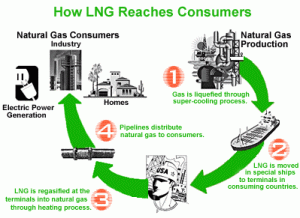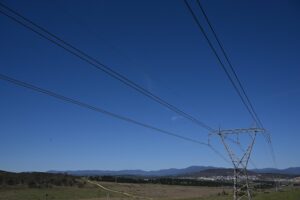Last year I explained why “Exporting Liquefied Natural Gas (LNG) Is Bad For The Climate — And A Very Poor Long-Term Investment.” It seems like Obama plans to press ahead with expanding LNG exports. So here’s a view from World Resources Institute.
By James Bradbury
US natural gas production is booming. According to the Energy Information Administration (EIA), production grew by 23 percentfrom 2007 to 2012. Now – with production projected to continue growing in the decades ahead – US lawmakers and companies are considering exporting this resource internationally. But what are the climate implications of doing so?
This is a topic I sought to address in my testimony yesterday before the US House of Representatives Energy and Commerce Subcommittee on Energy and Power. The hearing, “US Energy Abundance: Exports and the Changing Global Energy Landscape,” examined both the opportunities and risks presented by exporting liquefied natural gas (LNG). I sought to emphasize a number of points that are often overlooked in this discussion; in particular, fugitive methane emissions and cost-effective options for reducing them.
Environmental Impacts of Natural Gas Production
While burning natural gas releases half the amount of carbon dioxide as coal, producing the fuel comes with considerable environmental risks (see: here, here, and here). We’re already seeing these risks play out domestically. In addition to habitat disruption and impacts on local air and water quality, one of the most significant implications of natural gas production is fugitive methane emissions.
Methane is the primary component of natural gas. It escapes into the air as “fugitive methane emissions” along every stage of the natural gas production process.
The estimated leakage rate for natural gas systems was only about 1.4 percent of total production in 2011, according to the most recent greenhouse gas inventory. While this may not sound like much, it contributes significantly to climate change because methane is a potent greenhouse gas—at least 25 times stronger than carbon dioxide. In fact, this fugitive methaneamounts to more greenhouse gas emissions than all of the direct and indirect emissions from U.S. iron and steel, cement, and aluminum manufacturing combined. There is much need–and opportunity–for reducing these emissions.
Natural Gas Exports and Greenhouse Gas Emissions
The EIA projects that the United States will begin exporting LNG within the next five years, and that the country will become a net exporter by 2020. Exporting LNG may exacerbate the fugitive methane problem along with other environmental issues. Exporting natural gas raises three primary concerns from a climate change perspective:
1) More Fugitive Methane
EIA projects that exporting LNG would boost domestic production of natural gas, with roughly three-quarters of this production coming from hydraulic fracturing of shale gas. Increased production would mean increased fugitive methane, which would accelerate climate change. The good news is that there are cost-effective strategies to reduce fugitive methane emissions, but state and federal policies will be needed to ensure that these are widely implemented.
2) An Energy- and Emissions-Intensive Process
In order to send natural gas overseas, you must liquefy it, transport it, and then re-gasify it. This is an extremely energy- and emissions-intensive process. According to the National Energy Technology Lab’s 2012 Natural Gas Technology Assessment, liquefaction, transport, and gasification would add roughly 15 percent to U.S. natural gas production’s life cycle GHG emissions (see the figure below and my testimony for more details). These additional emissions more than double the total upstream GHG emissions from U.S. natural gas systems, significantly reducing the climate advantage that natural gas has over higher-emitting fuels like oil and coal.
 Liquefaction, transport, and gasification would add roughly 15 percent to U.S. natural gas production’s life cycle GHG emissions. Sources: Bradbury et al. 2013; Weber and Clavin, 2012; NETL, 2012; Burnham et al. 2011
Liquefaction, transport, and gasification would add roughly 15 percent to U.S. natural gas production’s life cycle GHG emissions. Sources: Bradbury et al. 2013; Weber and Clavin, 2012; NETL, 2012; Burnham et al. 2011
3) Domestic and International Energy Market Implications
Domestically, LNG exports would likely raise natural gas prices, resulting in the greater use of coal for U.S. electric power generation. Internationally, exporting LNG would contribute to an expanded natural gas market. This could produce mixed results: On the one hand, greater natural gas use could result in a slight reduction in global carbon dioxide emissions if the fuel replaces higher-carbon sources like coal and oil. However, the full climate benefit of this fuel-switching diminishes if cheaper, more readily available natural gas also undercuts efficiency and displaces the use of lower-carbon renewable and nuclear energy sources. The International Energy Agency accounts for this mixed bag of results in its Golden Rules scenario (in which the natural gas industry adheres to minimum environmental standards). It projects that greater supplies of natural gas would reduce global carbon dioxide emissions by a mere 0.5 percent annually by 2035.
These scenarios, however, do not account for current or projected rates of fugitive methane leaks. To put this in perspective,EPA estimates that the scale of leaked methane from global natural gas and oil systems is projected to be more than 10 times greater than the IEA’s estimated CO2 reductions from more abundant natural gas. In other words, while exporting natural gas may result in lower global carbon dioxide emissions, there is a significant risk that increased upstream fugitive methane could more than offset these benefits.
Lessening the Impact
Clearly, we need U.S. policies to reduce fugitive methane and other GHG emissions if natural gas and LNG are to be part of the climate change solution. To that end, there are ways to reduce natural gas’s climate impacts. The use of three cost-effective technologies and federal/state policy interventions could bring the average fugitive methane leakage rate down significantly, to below 1 percent. (WRI details these technologies and policy pathways in its working paper, Clearing the Air: Reducing Upstream Methane Emissions from U.S. Natural Gas Systems).
Federal legislators could take several actions to further reduce GHGs from natural gas systems, including: expanding applied technology research; providing technical and regulatory assistance to states in developing and implementing environmental regulations; and most importantly, putting a price on carbon or adopting a clean energy standard to encourage private investments in low-carbon technologies. (For a more comprehensive list of policy recommendations, please read my full Congressional testimony).
At the hearing yesterday, there was a great deal of enthusiasm for the positive role that LNG exports could play to advance U.S. interests economically and geopolitically. But many members also expressed words of caution, recognizing the potential environmental implications. There was general agreement among committee members and witnesses that protections should be in place to ensure that natural gas production is developed responsibly. This is an important opportunity for the United States to further improve its economic and geopolitical standing by showing leadership in addressing global climate change.
We can do this by ensuring that natural gas is used as a bridge to a low-carbon pathway – not as a panacea for addressing climate change. This requires both reducing upstream GHGs, and – if gas-fired power plants are to be a part of a longer-term energy future – using carbon capture and storage (CCS) technology. In other words, to achieve climate stabilization at relatively safe levels within 20 to 30 years, emissions from natural gas usage will need to decline to a fraction of current levels. We also need common-sense policies that promote the development, deployment, and export of a variety of low-emissions technologies, including renewables. We must ensure that the country’s use of natural gas enables, rather than hinders, a low-carbon transition.
– James Bradbury, reprinted with permission from WRI. You can read his full Congressional testimony here.








